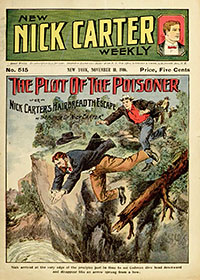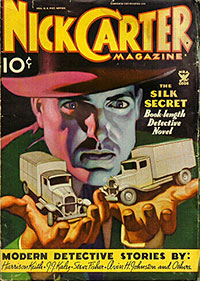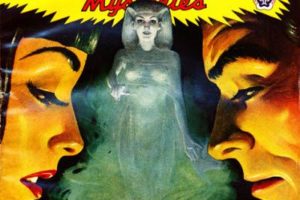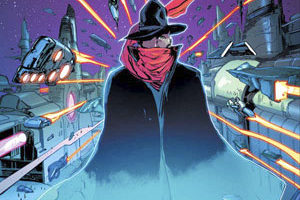 Nick Carter is a literary character which has been around a long time, was enormously popular during his time, but is today largely forgotten. He has appeared in a large number of forms — dime novels, pulp magazines, men’s adventure paperbacks, movies, radio, and comics, — and has also appeared around the world.
Nick Carter is a literary character which has been around a long time, was enormously popular during his time, but is today largely forgotten. He has appeared in a large number of forms — dime novels, pulp magazines, men’s adventure paperbacks, movies, radio, and comics, — and has also appeared around the world.
He first appeared in a story paper, the New York Weekly, published by Street & Smith in 1886. The son of Old Sim Carter, Carter was trained by his father from an early age to be a physical and mental marvel (sound familiar?), and was able to bench press horses, and was a master of disguise.
He pre-dated Sherlock Holmes, and was more inspired by previous dime novel detectives like Old Sleuth, Old Cap Collier, and Old King Brady (no, I don’t know why they liked using the word “Old” in their names). He was so popular that Street & Smith soon started the Nick Carter Weekly dime novel series. It would, in 1915, become the long-running Detective Story Magazine, and at that point, new Nick Carter stories ended after nearly 40 years! There would be reprints for a couple of years in the pulps, and several years of paperback reprints, but no more new stories.
While many of Nick Carter’s stories are standard detective fare, he also had several that are more fantastical, having him find lost races and such. He also dealt with an array of criminals, some unusual. A very notable one was Dr. Quartz, a sinister vivisectionist who returned several times to oppose Nick Carter.
Dr. Quartz is a clear forerunner to many of the great supervillains. He appeared to be killed many times, only to return. He appeared in over two dozen stories, and even came back during the Nick Carter revival in 1927. Other villains include Dazaar the Arch-Fiend, Burton Quintard (Nick’s first reoccurring foe), the six Dalney brothers and the six Bulwer sister, and many others.
From 1924 through 1927, S&S tried a revival of Carter in DSM. While many of Carter’s old villains returned, he apparently wasn’t the same as the old Nick.
Carter was popular oversees, as his stories were translated and printed in Europe. I don’t know if original Nick Carter stories were written in Europe, but he was popular enough that rival characters were created, like Ethel King, “the female Nick Carter”, and Miss Boston, noted as a former associate (collections of both reprinted by Black Coat Press). The French also did Nick Carter movies that would spawn further movie characters like Fantomas, Les Vampires, and Judex.
 But, as I noted, in 1927 a revival attempt ended. In 1930, S&S’s The Shadow took off, spawning the new hero pulp phenomenon. A revival of Nick Carter was considered, but Doc Savage came next, and made use of some of the elements of Nick Carter, especially his upbringing. So when they did bring Nick back in 1933, he was now a more standard hard-boiled detective, no more a physical or mental marvel or having fantastical villains like Dr. Quartz. His pulp lasted until 1936, but he also appeared in S&S’s comic book line. Another character that appeared was Nick’s adopted son Chick Carter, whom he had met out west and adopted when he noticed that Chick so resembled him (this back during the dime novel days).
But, as I noted, in 1927 a revival attempt ended. In 1930, S&S’s The Shadow took off, spawning the new hero pulp phenomenon. A revival of Nick Carter was considered, but Doc Savage came next, and made use of some of the elements of Nick Carter, especially his upbringing. So when they did bring Nick back in 1933, he was now a more standard hard-boiled detective, no more a physical or mental marvel or having fantastical villains like Dr. Quartz. His pulp lasted until 1936, but he also appeared in S&S’s comic book line. Another character that appeared was Nick’s adopted son Chick Carter, whom he had met out west and adopted when he noticed that Chick so resembled him (this back during the dime novel days).
Nick Carter would also star in a radio show in the 1940s and ’50s. And a movie trilogy starring Walter Pidgeon also came out (Warner Bros. Archives now makes them available). Chick Carter also got his own radio show.
Then in the 1960s with the James Bond craze and the new men’s adventure paperback series, the Nick Carter name was revised for the new Killmaster series. No apparent connection, “Nick Carter” was a counterspy known as a Killmaster, Agent N3 of Axe. About 260 volumes were published from 1964 to 1990. Most people who remember Nick Carter, it’s probably this series they are remembering.
Sanctum Books has started a reprint of the 1930s Nick Carter pulps, that have included some stories from the late 1920s (a trilogy of stories by Johnston McCulley and dealing with Doctor Quartz). I’m not aware of any effort to reprint any of the Nick Carter dime novels, though scans may be found of some online. Black Coat Press has reprinted some of the characters from Europe that were inspired by and were rivals to Nick Carter, but I’m not aware of reprints of stories from Europe. While dated, certainly the more fantastical stories could possibly be revisited. It’s too bad that this early forerunner to the hero pulps is not better known.




Robert Conrad played Nick Carter in a 1972 Made For TV Movie: “The Adventures of Nick Carter” which also was a pilot for a possible TV series if the ratings were good enough. Since we never got a Nick Carter TV series I think it’s safe to assume that the ratings weren’t there.
Nice write-up. Old Sleuth became VERY popular, and spawned imitators along the same lines. Though initially described as a young man who disguised himself as an old man, he was later simply described as an old man. Regardless, Old Sleuth became enormously popular, and subsequent “Old” characters used similar devices, sometimes as young men who used disguises, sometimes not.
Essentially, Old Sleuth was so popular that he became a character type. Publisher George Munro feuded with other publishers frequently to protect the Sleuth name.